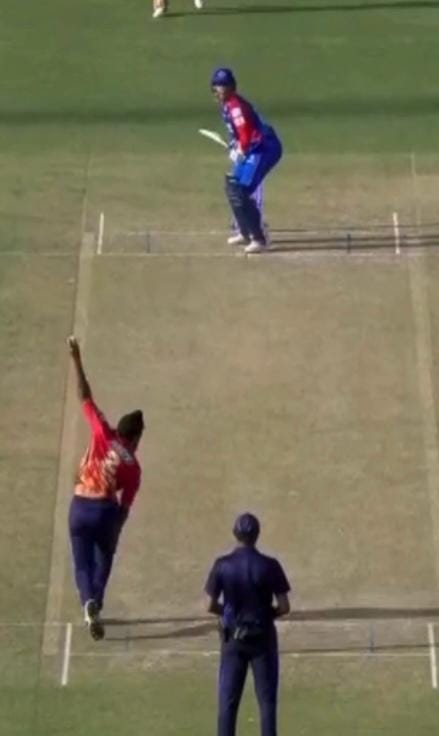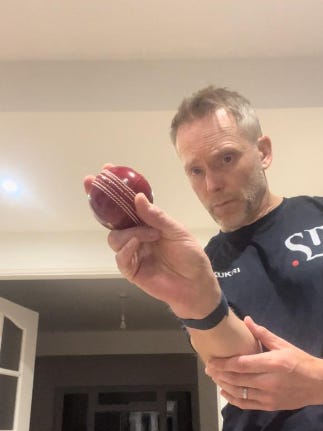Discover a Little-Known Bowling Technique That Only a Few at the Top of Their Game Know How To Execute.
Turn to this strategy as your last resort.
My purpose for starting this Newsletter is to make high-level Elite bowling coaching available to everyone.
I'm tired of hearing generic bowling coaching fixated on straight lines without nuance or top-tier coaches holding information back like some hidden recipe.
Bugger that.
Thirty years of my coaching and playing experiences will be unleashed here for free.
A common question that keeps popping up is what bowlers should do when the ball isn't showing any lateral movement, either through the air or off the pitch.
The answer is chillingly straightforward.
You're probably thinking, 'Alright, Barnsy, spill the beans!' Well, here it is.
You have to use angles.
When I worked in Bangladesh with their national and 'A' team, I learned that many cricketers were mostly from impoverished areas and, therefore, didn't eat very well from a young age. Because of the lack of nourishment, the strength required for a solid upright action was usually missing.
These up-and-coming seam bowlers lacked strength in the right places. They'd usually use a hint of ingenuity to bowl the ball quickly by slinging it. Think Lasith Malinga, although with slightly higher release points.
Most bowlers would have to do this because they weren't strong enough to hold themselves upright, which is the opposite of what we know about a conventional and healthy action.
Here's the thing.
The consequence of slinging is that it creates an unusual angle, and the seam position is different. Instead of being upright, the ball is released on a 2 o'clock to an 8 o'clock axis.
When the ball hits the pitch like a flying saucer, it scuffs up the sides of the ball, which, in terms of wear and tear, is perfect for reverse swing and a nightmare for batters.
This unintended result of a slingy bowling action is now a tactic elite bowlers employ for maximum effectiveness.
It has a threefold effect.
Reverse swing is in play.
Lower arm trajectory makes executing the yorker easier
The slingy action allows the bowler to use angles on the crease, cramping batters for room.
IPL magic.
Arshdeep Singh was incredible in the IPL recently.
It was the 19th over of a T20 game, and he could see the batter was deep in his crease, so he cleverly changed his angle by lowering the release point of his bowling arm.
People watching these games often miss the nuance when they're engrossed in the entertainment aspect.
For me, it was noticeable how Singh started his run up at an angle, so he would have to bowl the ball from wider of the crease. He starts from behind the umpire and almost runs towards a gully line, nowhere near the direction of the batter.
He did this purposely to change the angle and try to cramp the batter for room.
So he's running away from the target. However, as a consequence, he still wants to bowl the ball straight, which means he has to lower his release point.
Deliberately dropping your release point mechanically involves a slight adjustment, requiring you to pull through your chest.
It may feel like it resembles Malinga's bowling action, although if you ever watch it back on film, it's never as low as you think.
The easiest way to drop your release point is to copy Singh and get your energy across the crease.
From that direction, the only way to get the ball back online with the stumps is to drop your release point. Then, you're forced to pull through your chest and sling across your body.
This creates an awkward angle that can cramp the batter or force them to play on one side of the field. Also, the arm's lower trajectory makes it the perfect height to squeeze your yorker in.
Add reverse swing to the mix, and suddenly, it's a nightmare for batters.
Pro-tip:
Move your front arm across the body, which will then move it across the target. The shoulders will rotate horizontally, lowering the release point and slanting the seam position.
Final Thoughts.
When the ball isn't swinging or responding to any lateral movement off the pitch, using the angle of the crease and the angle of a lower release point is an Elite skill only a few at the top of their game have mastered.
If you want to become your best and push the limits of your skill set, adding these spokes to the bicycle tyre gives you more ammunition, particularly when batting conditions are favourable.
The unintended outcome of scuffing the ball could lead to reverse swing.
It's a skill worth trying during practice.
If you can master it and implement it effectively in a game, you'll have a competitive advantage.
Chat soon.







Yeh so straight arm just a lower release point. It was the most natural feeling action which allowed me to get some pace otherwise I felt like my shoulder almost had to shift into place to brush past my ear. I just wasn’t sure if this is something I should fix or not due to the lack of cricket I have played.
Just started playing cricket a year ago and I have a slingy action. I got told by some to straighten it and by some to carry on but this was definitely an interesting read. Is there any situation where you think someone should focus on straightening out their action ?